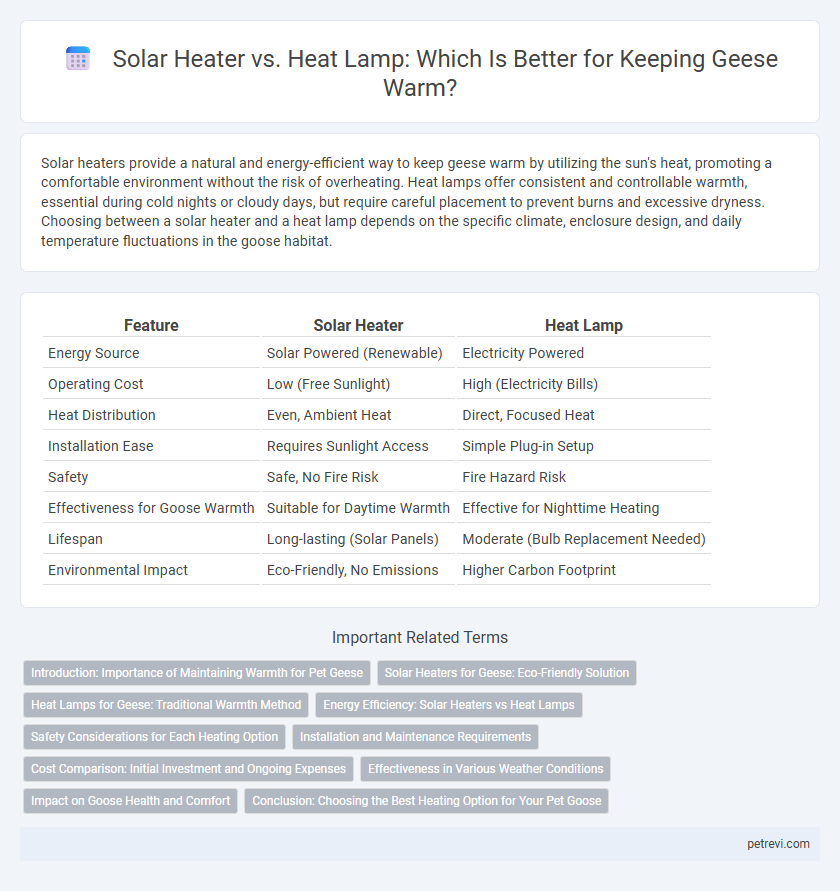Solar heaters provide a natural and energy-efficient way to keep geese warm by utilizing the sun's heat, promoting a comfortable environment without the risk of overheating. Heat lamps offer consistent and controllable warmth, essential during cold nights or cloudy days, but require careful placement to prevent burns and excessive dryness. Choosing between a solar heater and a heat lamp depends on the specific climate, enclosure design, and daily temperature fluctuations in the goose habitat.
Table of Comparison
| Feature | Solar Heater | Heat Lamp |
|---|---|---|
| Energy Source | Solar Powered (Renewable) | Electricity Powered |
| Operating Cost | Low (Free Sunlight) | High (Electricity Bills) |
| Heat Distribution | Even, Ambient Heat | Direct, Focused Heat |
| Installation Ease | Requires Sunlight Access | Simple Plug-in Setup |
| Safety | Safe, No Fire Risk | Fire Hazard Risk |
| Effectiveness for Goose Warmth | Suitable for Daytime Warmth | Effective for Nighttime Heating |
| Lifespan | Long-lasting (Solar Panels) | Moderate (Bulb Replacement Needed) |
| Environmental Impact | Eco-Friendly, No Emissions | Higher Carbon Footprint |
Introduction: Importance of Maintaining Warmth for Pet Geese
Maintaining consistent warmth for pet geese is crucial to prevent hypothermia and support their immune system during colder months. Solar heaters offer energy-efficient, sustainable heat by utilizing sunlight, making them ideal for outdoor enclosures with adequate solar exposure. Heat lamps provide immediate, controllable warmth but require careful monitoring to avoid fire hazards and overheated areas in the geese's habitat.
Solar Heaters for Geese: Eco-Friendly Solution
Solar heaters provide an eco-friendly solution for maintaining warmth in geese enclosures by harnessing renewable energy, reducing reliance on electricity compared to traditional heat lamps. They offer consistent temperature regulation while minimizing carbon footprint and operational costs, making them a sustainable choice for outdoor waterfowl care. Solar-powered heating systems also enhance animal welfare by preventing overheating and providing stable warmth aligned with natural day-night cycles.
Heat Lamps for Geese: Traditional Warmth Method
Heat lamps for geese provide a concentrated and reliable heat source that mimics natural warmth, crucial during hatchling development and cold weather. Unlike solar heaters, heat lamps offer consistent temperature control, enhancing gosling comfort and reducing stress-related health issues. Their traditional use in poultry farming highlights effectiveness in maintaining optimal conditions for goose growth and wellbeing.
Energy Efficiency: Solar Heaters vs Heat Lamps
Solar heaters offer superior energy efficiency for maintaining goose warmth by harnessing renewable sunlight, significantly reducing electricity consumption compared to heat lamps. Heat lamps rely on electrical resistance to generate heat, leading to higher energy costs and increased carbon footprints. Incorporating solar heaters can lead to sustainable warmth solutions while lowering operational expenses in goose care.
Safety Considerations for Each Heating Option
Solar heaters provide a safe, eco-friendly warmth option for geese, minimizing the risk of burns or fires due to their controlled temperature output and absence of exposed heating elements. Heat lamps, while effective at delivering immediate, focused heat, pose higher safety risks such as potential overheating, electrical hazards, and increased fire danger if not properly secured or monitored. Ensuring proper installation, regular inspection, and maintaining a safe distance from bedding material are crucial safety measures when using heat lamps for goose warmth.
Installation and Maintenance Requirements
Solar heaters for goose warmth require minimal installation efforts, often involving simple positioning in sunny areas and basic wiring to connect to a power source. Heat lamps, on the other hand, need secure mounting overhead and regular checks to ensure safe operation, with frequent bulb replacements and cleaning to prevent dust buildup. Maintenance for solar heaters is generally low, mainly involving occasional panel cleaning, whereas heat lamps demand higher ongoing attention due to fire risk and electrical wear.
Cost Comparison: Initial Investment and Ongoing Expenses
Solar heaters for geese have a higher initial investment compared to heat lamps, but they significantly reduce ongoing expenses by utilizing renewable energy, cutting electricity costs to nearly zero. Heat lamps require lower upfront costs but incur continuous electricity expenses, increasing total expenditure over time. Choosing a solar heater can provide long-term financial benefits despite the steeper start-up price, making it a cost-effective solution for maintaining warmth in geese habitats.
Effectiveness in Various Weather Conditions
Solar heaters provide consistent warmth for geese by harnessing renewable energy, making them highly effective in sunny conditions and reducing energy costs. Heat lamps deliver immediate and concentrated heat, ideal for colder or overcast weather when solar power is limited, ensuring reliable temperature control. Combining both systems can optimize warmth maintenance across diverse weather conditions, enhancing goose comfort and health.
Impact on Goose Health and Comfort
Solar heaters provide consistent, natural warmth that supports a goose's thermoregulation and reduces stress by mimicking outdoor sunlight, enhancing their immune function and overall well-being. Heat lamps offer controlled, immediate warmth but can cause uneven heat distribution, leading to potential overheating or dryness that may stress the geese and impair feather quality. Optimal goose health and comfort depend on balanced temperature control, making solar heaters the preferable choice for sustained, natural warmth without disrupting natural behaviors.
Conclusion: Choosing the Best Heating Option for Your Pet Goose
Solar heaters provide an energy-efficient and cost-effective solution for maintaining consistent warmth for pet geese, using renewable solar energy to reduce electricity expenses. Heat lamps offer targeted, immediate heat but consume more electricity and pose a fire risk if not properly managed. Selecting the best heating option depends on your specific environment, budget, and safety considerations, with solar heaters often preferred for sustainable, long-term comfort.
Solar heater vs Heat lamp for Goose warmth Infographic

 petrevi.com
petrevi.com